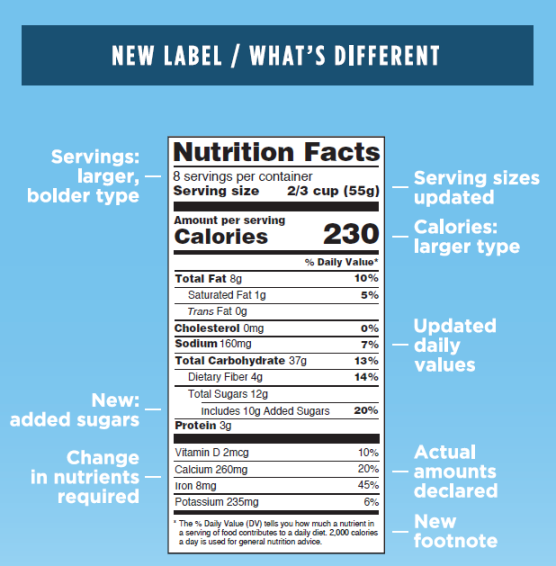After 9 arduous years of deliberations, the FDA finally rolled out the final rule on the new food label last week.
In a nutshell, the biggest changes you will notice by 2018 are outlined in the FDA’s infographic:
Much of the food label media attention has centered on 3 of the most obvious changes:
- More realistic serving sizes (so long 1/2 cup of ice cream serving…)
- Addition of the added sugars line (bad news for the entire “fruited yogurt” industry…), and
- Changes in nutrients required (adding vitamin D and potassium and deleting vitamins A and C).
Most nutrition advocates are generally pleased with the direction of the food label change. First Lady Michelle Obama summarized the changes by saying, “Very soon you will no longer need a microscope, a calculator or a degree in nutrition to figure out whether the food that you’re buying is actually good for your kids, so that’s a phenomenal achievement.”
But how did fiber fare with this food label overhaul?
There are 2 changes with regards to fiber on the new food label:
- The FDA defined dietary fiber for the first time saying fiber, “includes naturally occurring fibers and only fibers added to foods that show a physiological health benefit”
- The Daily Value (DV) for fiber will be changing from 25 grams to 28 grams per day
With regards to the definition of fiber, the FDA determined that there is adequate scientific evidence to support the notion that the following added fibers may have beneficial health effects for humans:
- Cellulose (improves bowel function)
- Guar gum, pectin, locust bean gum and hydroxypropylmethylcellulose (lower blood total and/or LDL cholesterol values)
- Psyllium husk (aka inulin and was added to the definition of fiber because of its role in bowel health)
This refined definition also means that all of the other functional (added or “fake”) fibers you find added to processed foods will not be able to count as dietary fiber since there is no evidence supporting their beneficial effect on health.
And what about the change in daily value from 25 to 28 grams? Well, let’s keep this in perspective: most Americans eat only 12-15 grams per day, so most of us would still benefit from eating more fiber. Whether that’s 25 or 28 grams probably doesn’t matter: we need to eat more plants and less processed foods with food labels on them.
Manufacturers will have to roll out the new food label by July 26, 2018. For companies with less than $10 million in annual food sales will be given an additional year to comply.
As renowned nutrition expert Marion Nestle so eloquently put it in her Scientific American blog post today, “But let’s keep this in perspective. Healthful diets are based on foods, not food products. We would all be healthier eating foods that do not come with Nutrition Facts panels, and saving most of those that do for once-in-a-while occasions.”

